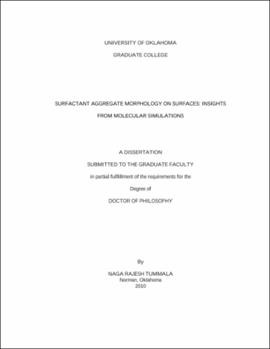| dc.description.abstract | Surfactants are an important class of molecules used in number of applications at a range of length scales. Oil recovery, mineral recovery, detergency are applications that have been using surfactants for decades, whereas colloidal dispersions of nano-particles, preparation of nano-porous materials, dispersing carbon nanotubes are new applications of surfactants that are currently gaining prominence. The aggregate structure of surfactants plays an important role in determining the structure of nano-porous materials, ability of surfactants to disperse colloidal particles, carbon nanotubes and graphene nanosheets. To better understand such mechanisms at the nanoscale, we employed molecular dynamics simulations to study aggregation structure of surfactants (anionic sodium dodecyl sulfate (SDS)) at vacuum-water, water-graphite, water-silica, water-graphene and water-carbon nanotube interfaces. We also performed simulations of non-ionic mono dodecyl hexaethylene glycol (C12E6) at vacuum-water and water-silica interfaces for the purpose of comparing the results to those obtained for SDS at those interfaces. The results from the SDS aggregate morphologies at water-graphite (hydrophobic) and water-silica (hydrophilic) interfaces indicate that the aggregate morphology of SDS surfactants changes drastically with the change in the nature of the substrate. The comparison of results from water-graphite and water-graphene nanosheets and water-graphene nanoribbons indicate that lateral confinement effects are predominant at length scales comparable to the size of the SDS molecules, and diminish gradually as the substrate size increases. The effect of the substrate curvature on the SDS surface aggregate structure has been studied by simulating SDS at water-single walled carbon nanotube (SWNT) interfaces on SWNTs of different diameters and inside SWNTs. The results indicate that curvature, and also the surface coverage of the SDS surfactants influence the aggregate morphology. We also studied the aggregate structure of the flavin mononucleotide (FMN) molecules at water-SWNT interfaces. Finally, we predicted the effective interaction between two SWNTs in presence of SDS surfactants and FMN molecules at two different surface coverages. The knowledge of the effect of the different surfactant molecules on the effective interaction between nanotubes in aqueous dispersions will aid in the design of better surfactants to enhance the SWNTs dispersion and separation. | |
